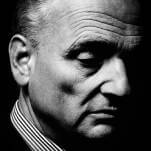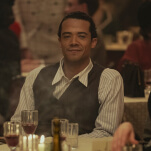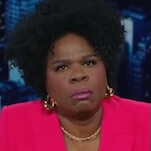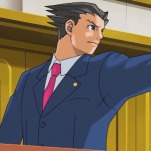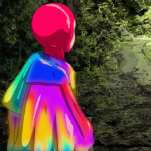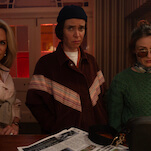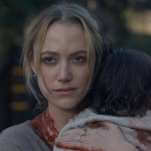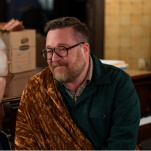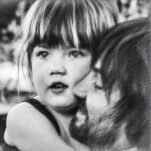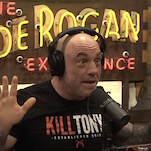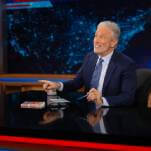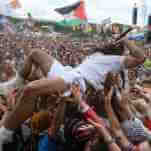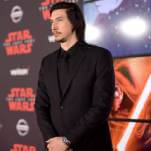“The final party begins.” –Vincent Volaju-
This is it, Space Cowboys: the last review in my coverage of Cowboy Bebop for the AV Club. Now that the series proper has finished, I’ll be taking a look at Cowboy Bebop: The Movie, a feature film that I rather like in spite of how doughy it is. Released almost two years after the show wrapped up in 1999, Cowboy Bebop: The Movie (also known as: Cowboy Bebop the Movie: Knockin’ on Heaven’s Door) takes place sometime before “Brain Scratch” (Big Shot is still on the air, after all). It’s not a second series finale, in other words, but its conclusion does add a little extra closure to the show’s final two-parter.
By the end of the movie, you get the sense that the ending of “The Real Folk Blues (Part 2)” is definitely the end of Spike Spiegel. Fighting Vincent Volaju in Cowboy Bebop: The Movie may not have been the right time for Spike to kick off, as is suggested in the middle of the movie. But fighting Vicious definitely was. On top of that, when Vincent does die, he comes to the realization that there’s nothing waiting for him after death. He exclaims that he now knows there’s no afterlife (“But now I understand, there is no door.”), which is a fascinating concept, especially when you consider that Spike’s character arc begins and ends the notion that eventually, he will die. So now we know: when Spike dies in “The Real Folk Blues (Part 2),” he’s not coming back, in any form.
The movie’s semi-convoluted plot revolves around a mysterious nano machine virus that Vincent threatens to unleash on an unsuspecting Martian populace. As we learn over the course of the film, Cherious Medical manufactured the virus for the Martian military. Now, Cherious has hired Electra to find and neutralize Vincent, who is being helped by a delusional hacker named Lee Sampson. Electra and Vincent were members of Unit 7, a Martian Special Forces unit that was disbanded three years before the movie’s events. Unit 7 was experimented on to test both the effects of the original nano machine virus. This experiment was not only deeply immoral but highly illegal because of the Treaty of Amsterdam, which apparently bans the use of nano machine viruses in war. Only Vincent survived the experiment since he was injected with anti-nano machines (Really? They couldn’t have thought of a better way to put this?). So Cherious wants to stop Vincent in order to wash their hands of the incident. Spike wants to know more about Vincent because, “We share similar souls.” And the rest of the Bebop crew wants to find Vincent because there’s a 300 million-woolong bounty on his head.
Vincent is presented as one of the biggest threats the Bebop crew have faced just from the way that Faye first encounters him. He looks like he’s moving in slow motion, a visual association that is inadvertently transferred onto the mysterious veiled woman that Spike sees in the bazaar before talking to Rashid (look forward to speculating about who this woman is in the comments section; as I see it, it could be Julia, Electra or maybe even a weird manifestation of Vincent, though that last option is a long shot, no? Is this even a mystery? Did I miss something?). On top of that, most of the violence that occurs around Vincent is notably over-the-top. Spike and Vincent’s first fight on the train is especially excessive, full of fish eye lens shots of gun barrels thrust into the foreground, blood and breaking glass. And oh yeah, how can one forget that near-fatal twist of Spike’s heart?
It’s fitting that Vincent is a more severe threat than what Bebop fans are used to since everything else in the movie is generally grandiose. With the increase in production values, the creators of Cowboy Bebop: The Movie made a point of blowing up the show’s scale. The film’s production values are obviously bigger than the show’s were, the violence is significantly amped up and the plot revolves around the actions of several competing factions: the ISSP (space cops, basically), the Martian military, Vincent, Cherious Medical, Electra, and the Bebop crew, who separate into smaller groups throughout the film in order to try to stop Vincent.
This expansion of the show’s relatively small scale is not always successful. Screenwriter and series writer Keiko Nobumoto is at his best when dealing with small-scale, character-driven scenes, like the terrific opening robbery scene at the convenience store. The convoluted stuff about the nano machine virus, particularly the bits about the transformation of lymph corpuscles and bone marrow, felt padded. Generally speaking, Spike’s interactions with Rashid were pretty satisfying, but I wish they told us more about why Spike is similar to Vincent. Presumably, that kind of discussion is exclusively within the province of Spike’s shaman. Still, I kinda wish Rashid were more than just an exotic MacGuffin.
The movie’s bigger set pieces are also mostly fine, though most of them could have been edited a little more aggressively so that they didn’t feel like a lot of very good sequences surrounded by some decent but uninspired footage. The concluding fight scene, set in what I assume is only a replica of the Eiffel Tower, felt unnecessarily flabby. And while I love the dogfight Spike gets into with the ISSP, especially all the unusual forced perspective shots from behind and around the side of the various ships, I felt it also could have been a little shorter. The best fight scenes in the film are Spike’s first fight with Vincent on the train and Spike’s hand-to-hand fight with Electra, both of which felt like they went on for exactly as long as they needed to.
That having been said, while the bigger scale of Cowboy Bebop: The Movie sometimes felt forced, Yoko Kanno’s typically excellent score felt like a mostly organic way to ground the story in a believably bombastic context. There’s the haunting music playing during Rashid’s explanation of Vincent’s anti nano machine condition, a piano instrumental with beautiful vocals. Or the pseudo-Arabian number during Spike’s fruitless retracing of his steps to find Rashid, the one that concludes with Spike seated under some movie posters.
I was especially impressed by the crowd sequence that caps this scene. We see throngs of people at sundown slowly walking by Spike. And, if you look hard enough, you’ll notice that unlike the earlier crowd scene, Spike’s not another face in the crowd (the image is screencapped above). In fact, he’s not there at all. It’s an evocative image that says so much without really saying much of anything. Life will go on without Spike and the gang. But as Vincent says to Electra, “I’m so glad we could meet again at the end.”

